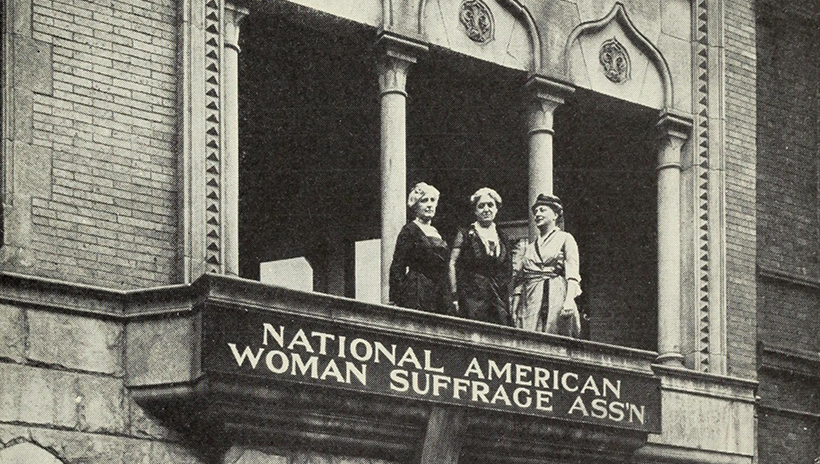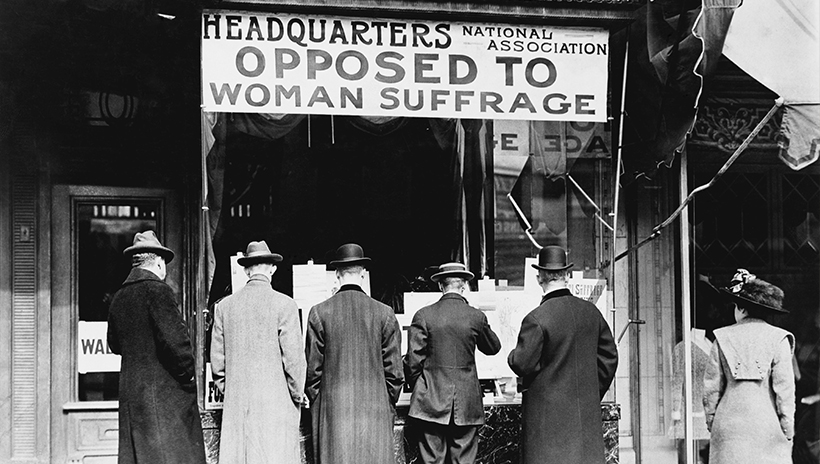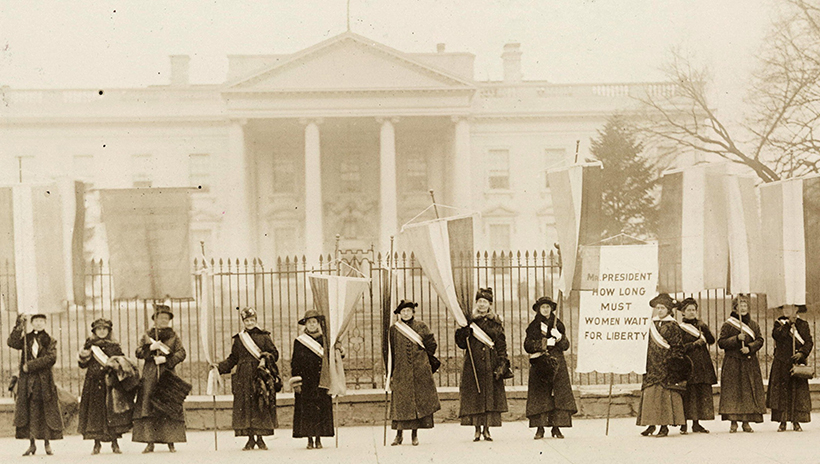Women’s History Month Spotlight: Winning the Vote: 1900–1920

In the opening years of the 20th century, the campaign to win voting rights for women seemed to have run out of steam, but within ten years, it had gained new energy. During this period, campaigners split into two main groups, each of which used different methods in their attempt to achieve women’s suffrage (the right to vote in elections). Thanks to the efforts of some remarkable women, the campaigners achieved their objective in 1920. On August 26, the 19th Amendment to the U.S. Constitution was passed, granting all women the right to vote.
Time for Change
The women’s suffrage movement had begun in the 1840s under the leadership of such inspiring figures as Susan B. Anthony and Sojourner Truth. However, by the end of the 19th century, most of the early leaders were either dead or no longer actively campaigning. In 1900, Susan B. Anthony resigned as president of the National American Woman Suffrage Association (NAWSA), leaving Carrie Chapman Catt in charge of an organization that was very low on funds.

As the new president of NAWSA, Catt faced some daunting challenges. By 1900, women had gained the right to vote in only four western states (Wyoming, Utah, Colorado, and Idaho), and it seemed unlikely they would do so in any other states. The NAWSA members were scattered, inactive, and discouraged. To add to Catt’s problems, there was a powerful anti-suffrage movement that opposed any change in society as dangerous, unnatural, and even sinful for breaking God’s law.
Catt’s “Society Plan”
Fortunately, Catt rose to the challenge. Recognizing that suffragettes were generally seen as dangerous outsiders, she devised a “society plan” to give her movement a new image of respectability. In the early years of the 20th century, she set about recruiting “society women” from wealthy families all over America. By gaining the support of these powerful women, she made NAWSA respectable and gained the financial backing she needed.
Once she had secured support and funds, Catt concentrated on campaigning at the state level. NAWSA directed most of its resources into a few key campaigns, where there was a strong chance of winning. This approach paid off in 1910 when Washington State granted women the right to vote; California followed suit in 1911. Over the next five years, suffrage was also secured in Arizona, Kansas, Oregon, Montana, Nevada, Illinois, and Alaska.
Splitting Away
In 1905, Carrie Chapman Catt resigned as president of NAWSA to care for her husband, who was seriously ill, and was replaced by the less dynamic Dr. Anna Howard Shaw. At the same time, some members of the suffrage movement were becoming impatient with NAWSA’s approach. Women such as Alice Paul, Lucy Burns, Harriot Stanton Blatch, and Alice Stone Blackwell wanted to try more militant methods and began to form breakaway groups.
Militant Methods
The most successful new group was the Congressional Union for Woman Suffrage (CUWS). Created in 1913 by Alice Paul and Lucy Burns, it was later reorganized as the National Woman’s Party (NWP) in 1916. By 1914, the CUWS had a membership of 4,500 and had raised more than $50,000 for its campaign. It also had its own magazine, The Suffragist, filled with radical articles and cartoons and edited by courageous journalist Rheta Childe Dorr.
Following the example of the British suffragettes, members of the CUWS held large demonstrations, parades, and motorcades and organized public debates on street corners. They recruited working-class women to their cause, combining demands for suffrage with campaigns for workers’ rights.
Anti-Suffragists
The militant methods adopted by the CUWS resulted in a surge of anti-suffragist feeling. The anti-suffragist movement consisted of men and women who believed a woman’s proper place was in the home. Anti-suffragists claimed that if women were allowed to vote, American family life would be threatened.

The majority of anti-suffragists merely expressed negative opinions about the suffrage movement, but a few joined official associations. The New York State Association Opposed to Woman Suffrage was founded in 1897. In 1908, it had over ninety members active in producing pamphlets and publications explaining its views.
A “Winning Plan”
In 1915, Carrie Chapman Catt once again became president of NAWSA and soon announced her “winning plan” to push a suffrage bill through the Senate. Catt worked hard to achieve this aim by gently pressuring senators and congressmen and by persuading the president himself. As part of her campaign, she urged all her supporters to “keep the suffrage noise up” around the country.
Silent Sentinels
While NAWSA members followed Carrie Chapman Catt’s plan, the leaders of the National Woman’s Party adopted more radical tactics. In January 1917, Alice Paul and Lucy Burns led the National Woman’s Party in a daring campaign. It involved women protesters standing outside the White House in a silent, nonstop vigil. The protesters held placards demanding equal rights for women and vowed not to leave until President Woodrow Wilson had agreed to give his support to women’s suffrage.

At first, the president ignored the “silent sentinels,” but in June 1917, police began to arrest protesters on the charge of obstructing the traffic. Many of the women were sent to prison, and some went on hunger strikes in protest against the conditions there. In a few cases, women were tortured and beaten, and when reports reached the newspapers about their treatment, there was a public outcry. In November 1917, all the women were released, and in March 1918, a judge declared that the arrests, trials, and imprisonments had all been illegal. By then, President Wilson had been converted to the suffrage cause and had urged the Senate to give their support to voting rights for women.
World War I and the Suffragists
After the United States entered World War I in April 1917, the different branches of the suffragist movement responded in contrasting ways to the new situation. Under the leadership of Carrie Chapman Catt, NAWSA members followed a patriotic line. Campaigners ceased to criticize the president and adopted a much more low-key approach in their campaigns. By contrast, the National Woman’s Party, led by Alice Paul, remained as determined as ever in its protests.
The silent sentinel campaign was not interrupted, and protesters continued to carry placards attacking the president. This had the effect of turning many members of the public against them, and some of the “sentinels” were assaulted both verbally and physically because of their alleged lack of patriotism. However, as the months wore on and the sentinels suffered increasingly harsh treatment, many people changed their minds and began to support the women’s cause.
The Pressure Mounts
By the beginning of 1918, pressure was mounting on President Woodrow Wilson to take action on women’s suffrage. Public sympathy had moved toward support of the silent sentinels, and Carrie Chapman Catt had been busy behind the scenes pursuing her highly effective campaign of persuasion. In addition, there was a growing public belief that the women who served their country in the war deserved to be granted equal rights with men.
The 19th Amendment
On January 10, 1918, a suffrage bill was brought before the House of Representatives. The bill proposed an amendment to the U.S. Constitution that would grant voting rights to all American women. On the previous evening, President Wilson had made a widely published appeal to members of the House of Representatives recommending that they pass the bill and stressing its importance as a war measure. The bill was passed by a margin of one vote and brought to the Senate.

On September 30, 1918, President Wilson appealed to the Senate to pass the suffrage bill, speaking passionately about the contribution that American women had made to the war effort. But despite the president’s efforts, two votes were lacking to gain the majority needed to pass the bill. It took a determined nationwide campaign by suffragists to secure sufficient support for the bill, but on June 4, 1919, the Senate eventually gave its approval. The 19th Amendment to the Constitution became law on August 26, 1920. Three months later, a presidential election was held, and for the first time, women in all states had the right to vote.
After the Amendment
Once the suffrage movement had achieved its aims, a different kind of organization was needed. The National League of Women Voters (NLWV) was established in 1920 to educate women about their rights, study national social policy, and take part in local politics. The NLWV also sponsored Women’s Equality Day, held on August 26 to celebrate the anniversary of the 19th Amendment. However, the battle for universal suffrage was not yet won. Many African-American women still faced obstacles when they went to vote, and some courageous women championed their cause.
Excerpted from “Winning the Vote: 1900–1920,” American History, Infobase, Accessed March 2021.